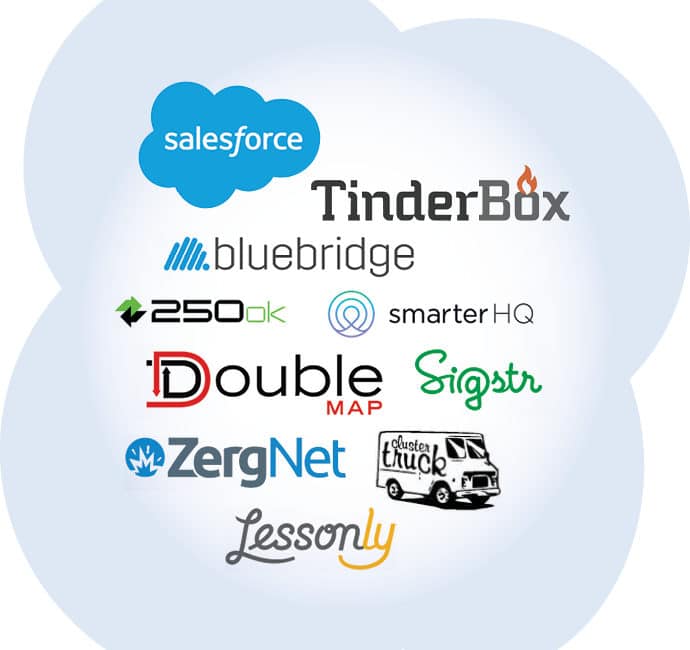
Indy’s Tech Ten
This article is part of Indianapolis Monthly’s February 2016 Tech City package. For more on this window into the city’s tech world, click here.
Hover over or tap the image for more information.
Salesforce
What: A San Francisco–based cloud computing company launched in 1999 that bought Indy’s email marketing giant ExactTarget in 2013 for $2.5 billion.
Why: Hard to ignore a business with $5 billion in annual revenue and a $55 billion acquisition offer from Microsoft.
What’s Next: Finding a downtown building with enough space to accommodate its 1,400 local employees for what insiders call the “East Coast headquarters.”
Tinderbox
What: A sales proposal, contracts, and presentation software company founded in 2010.
Why: Former ExactTarget CEO Scott Dorsey serves as chairman of the board, which may help explain the business’s $12 million in fundraising in the last three years.
What’s Next: Growing from its current 60 employees to the 95 it promised the state it would have by 2016 to qualify for tax credits.
Bluebridge
What: A company that makes apps for churches, universities, and tourism destinations, started in 2011.
Why: With $3.5 million in recent funding and clients from Purdue University to South Africa, Bluebridge has earned its fancy new offices.
What’s Next: There’s a lot of competition in the app business. Founder Santiago Jaramillo has emphasized the need to grow fast before the industry consolidates.
250ok
What: An “inbox placement” software company, experts at getting around your spam filter.
Why: Founder Greg Kraios started his career as ExactTarget’s first analyst in charge of studying which emails were being opened and why. He took what he learned to found a company in 2012 that counts Adobe as a client and has 500 percent annual growth.
What’s Next: Catching up to their enormous competitor, New York–based Return Path (which just opened an office in Indy).
SmarterHQ
What: A software firm that helps online retailers predict customer behavior via their web searches.
Why: The company, opened in 2010, raised $8 million in 2015 alone (including money from the Simon Venture Group) and landed customers like Eddie Bauer and Finish Line.
What’s Next: Convincing other big brands that the huge “cloud companies” (including Salesforce) can’t do this as well as a group like Smarter HQ, which specializes in it.
DoubleMap
What: An app that tracks the location of city and university buses in real time.
Why: Co-founded in 2011 by legendary Indy businessman Beurt SerVaas’s grandson, Peter SerVaas, DoubleMap follows buses from Bloomington to New Mexico. It has won multiple Mira Awards, the Oscars of the local tech scene.
What’s Next: IndyGo. Please. An out-of-state competitor has been promising to deliver these features for years.
Sigstr
What: A 2013 startup that posts ads at the bottom of email signatures, a space few other companies are exploring.
Why: The Scott Dorsey–led firm High Alpha backs Sigstr, which claims an average office worker sends 10,000 emails a year—a staggering number of missed opportunities to talk to a targeted audience.
What’s Next: Growing fast enough to fill this niche before the few overseas competitors they do have inspire others here.
ZergNet
What: A content-recommendation startup that has gotten you to click on hundreds of “Articles You Might Also Like.”
Why: Mark Cuban invested early in the 2012-founded ZergNet, which now has 40 million visitors every month.
What’s Next: After running for years on venture capital, ZergNet began charging publishers to promote their content last summer. Convincing clients to pay for traffic they once got for free will be the challenge.
Lesson.ly
What: A job-training software company cooked up by 27-year-old Max Yoder in 2012.
Why: With clients such as Lyft and Angie’s List, Lesson.ly’s revenue grew 850 percent last year. And it’s the only business in Indy with all three ExactTarget founders as investors.
What’s Next: Lesson.ly needs to double its current staff of 20 this year in order to meet the 400 percent revenue growth it has promised investors.
Clustertruck
What: A company formed last year that licenses the recipes of food trucks, prepares them, and delivers them to customers who order online.
Why: Owner Chris Baggott says it will be a billion-dollar company, and having co-founded ExactTarget, he knows something about those.
What’s Next: Bringing it to market. Software is still in the pre-launch stage, and the business is building its first kitchen on the corner of Pennsylvania and St. Clair streets.
And if we do say so ourselves…
NextRadio
What: An FM radio app that Emmis Communications (which owns Indianapolis Monthly) launched in 2013 hoping to transform the struggling radio industry.
Why: Since AT&T, Sprint, and T-Mobile agreed to turn on the FM chip present in every Android smartphone in the country, 5 million people have downloaded the interactive app, which uses a fraction of the wireless data that streaming does.





